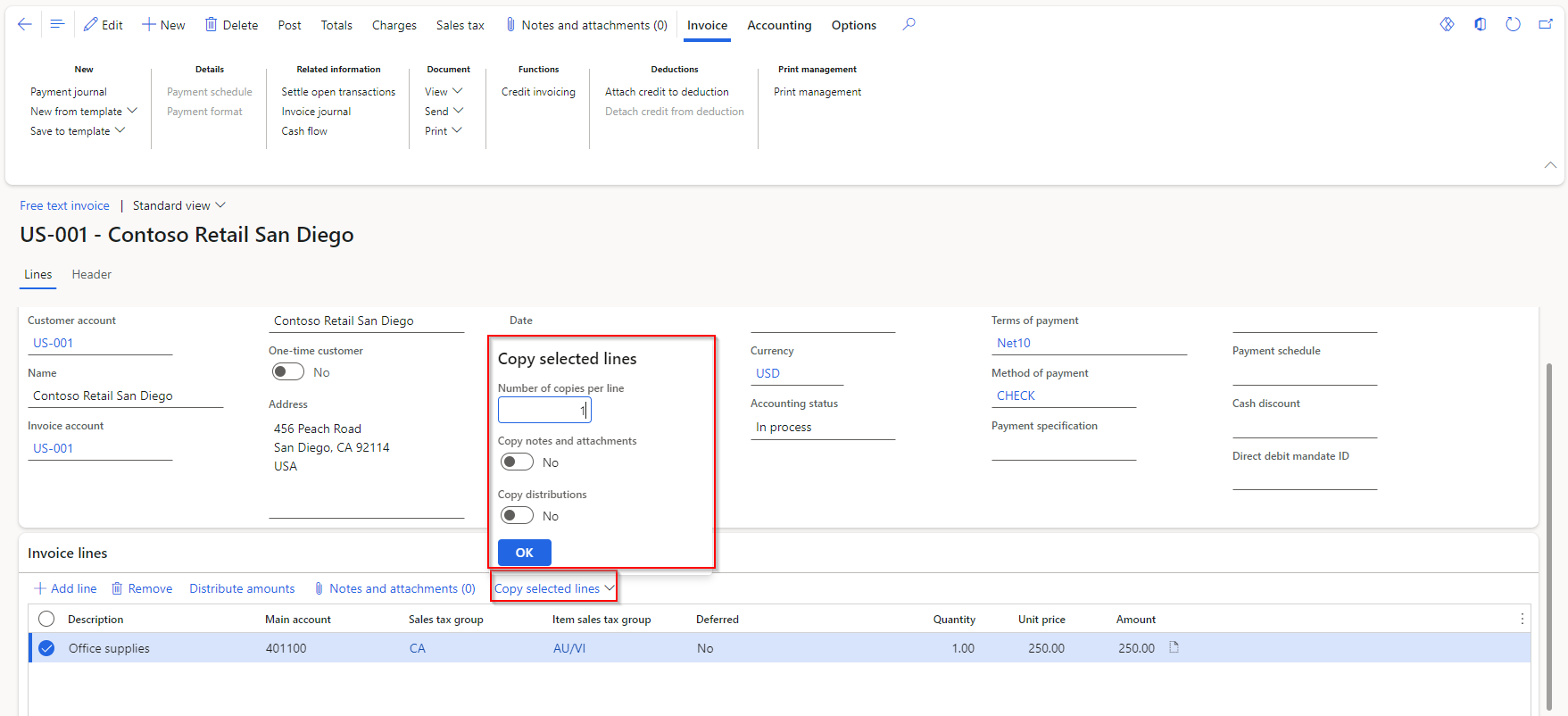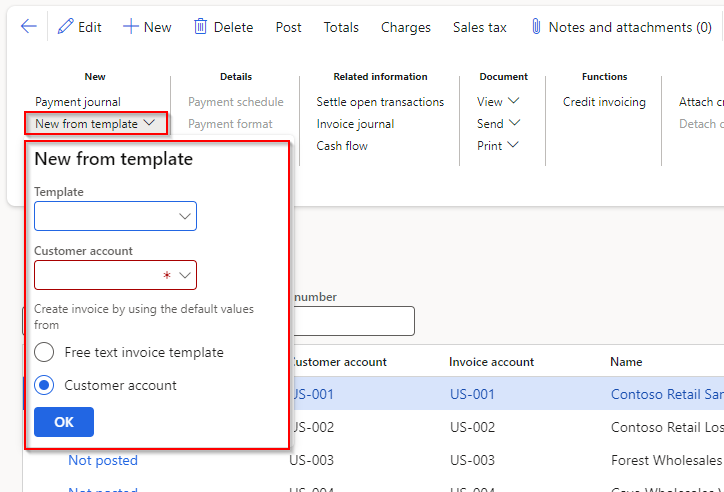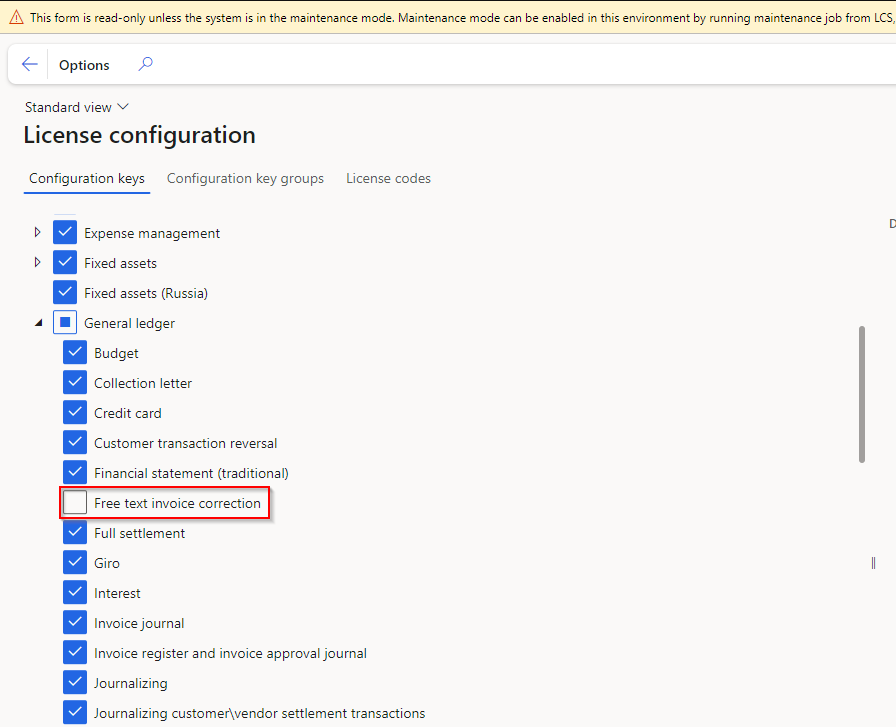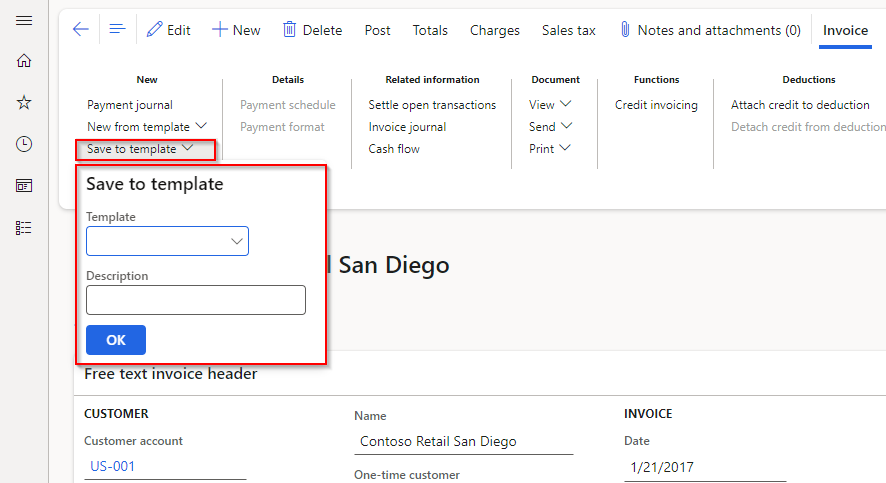Create free text invoices
This unit explains the operations of processing orders, recording invoices, and processing payments to demonstrate the process of Invoice-to-cash.
The difference between a free text invoice and a standard invoice is described in the following sections.
Sales order invoice
The sales order invoice differs from free text invoices in the following ways:
- The user specifies the item number, and the system posts the item-related transactions in the ledger. Users can also create sales orders with non-inventory items.
- A sales order makes inventory transactions, but a free text invoice never uses item inventory because it does not create stock transactions. Frequently, free text invoices are used to sell fixed assets because the free text invoices calculate the costs or income when you depreciate and sell the asset. Refer to the Fixed Assets training manuals to learn more about the fixed asset topic.
Free text invoice
Free text invoices differ from the sales order invoice in the following ways:
- No item numbers are specified by the user.
- The user selects a ledger account for the sale, which is displayed on each order line. The system posts the customer balance to the summary ledger account for the posting profile that was inherited from the customer, unless the user specifies a different posting profile on the free text invoice.
Free text invoices
Use free text invoices to create a sales invoice with order lines that include, but are not limited to, the following elements:
- Ledger accounts
- Free-text descriptions
- The entry of a sales amount
You cannot enter an item number on this kind of invoice; however, you can enter the appropriate sales tax information.
Frequently, a free text invoice line can be used to sell a quantity of some type of goods, services, or rights. For this reason, enabling the quantity to be identified on the line might be necessary. Similarly, if a good, service, or right has a unit price, it is important to capture this information on the free text invoice line. Providing this information to the user and a basic amount calculation helps identify and explain charges to customers.
You can enter quantity and unit price to automatically calculate the amount; however, if you have a unit price and modify the Amount field, the unit price value is deleted, regardless of the value in the Quantity field. Consequently, you have a total amount for the quantity indicated in the line.
Copy lines on a free text invoice
To copy lines on a free text invoice, select one or more lines and then select Copy selected lines. You can specify the number of copies to make, and then copy notes and attachments. You can either copy the distributions or let them be re-created when you post.
Accounts receivable > Invoices > All free text invoices
After copying lines, you can edit the information as you require.
Create a free text invoice from a template
You can create a free text invoice from a template. When selecting New from template on the Invoice tab, you can select a template name and the customer account for the new free text invoice. Default values, such as the terms of payment and method of payment, can be automatically filled in by the customer, or you can use the values that were saved in the template.
As a result, a new free text invoice is created, and you can edit the values as you require.
Accounting distributions
You can use the following buttons on the Free text invoice page to view, and possibly change, the accounting distributions for each amount on the free text invoice.
- Distribute amounts - View and change the accounting
distributions for an individual line and any child lines, such as
taxes or charges. You can also view and change the accounting
distributions for the child line directly from the Sales tax
transactions page or the Charges transactions page.
- Change free text invoice header amounts, such as charges or currency rounding amounts.
- Change free text invoice line amounts.
- View distributions - View the accounting distributions for all
lines on the document. You can't change the accounting
distributions from this view.
- View header amounts.
- View line amounts.
Distributing taxes
Accounting distributions for taxes cannot be created until taxes are calculated. To calculate sales taxes, complete one of the following tasks on the Free text invoice page:
- View the sales tax
- View the invoice total
- View the cash flow
- View accounting distributions for the whole free text invoice
- View the subledger journal
Accounting distributions and subledger journal entries for free text invoices
Accounting distributions are used to define how an amount is accounted for, such as how the revenue, tax, or charges are accounted for on a free text invoice. Every amount that must be accounted for when the free text invoice is journalized has one or more accounting distributions.
Correct a free text invoice
Enter corrections to modify a free text invoice that has been posted. When you correct an invoice that has been posted, a corrected invoice is created where you can modify the invoice and post it with the new values. When you post the corrected invoice, a canceling invoice is created, which brings the combined balance of the original invoice and the canceling invoice to a zero amount.
For example, if you correct an original posted invoice that has a balance of 500.00, a corrected invoice is created that has a balance of 500.00. You can change the information for the invoice and then post it. When the corrected invoice is posted, a canceling invoice is created that has a balance of -500.00. This process brings the combined balance of the original and canceling invoices to 0.00.
To correct a free text invoice that has already been posted, open the posted free text invoice. On the Invoice page, select Cancel and then select Correct invoice. Select a reason code, add comments, and select the date for a new corrected invoice. You can modify the corrected invoice and post it.
When you post the corrected invoice, a canceling invoice is created for a credit amount that equals the original invoice amount. Therefore, the combined balance of the original invoice and the canceling invoice is 0 (zero). The canceling invoice is settled against the original invoice.
After posting the corrected invoice, you have three invoices:
- Original invoice - The invoice that includes the information that you're correcting.
- Canceling invoice - The system-generated credit invoice that was created to cancel the invoice that was most recently corrected.
- Corrected invoice - The invoice that contains the corrected invoice information.
You can identify canceling and correcting invoices in two ways:
- The All free text invoices page includes a Correction column, where you can view which invoices are canceling invoices and corrected invoices.
- The header of the free text invoice shows a status of Canceling invoice '[invoice number]' or Corrected invoice '[invoice number]'.
This feature is available only if the Free text invoice correction configuration key is selected.
System administration > Setup > License configuration
Save a free text invoice as a template
You can also save an existing free text invoice as a template. When you select Save to template from the Invoice tab, provide a name and a description for the template. If a template with the name already exists, you see a notification that a template with that name already exists. You can still select OK to replace it.



